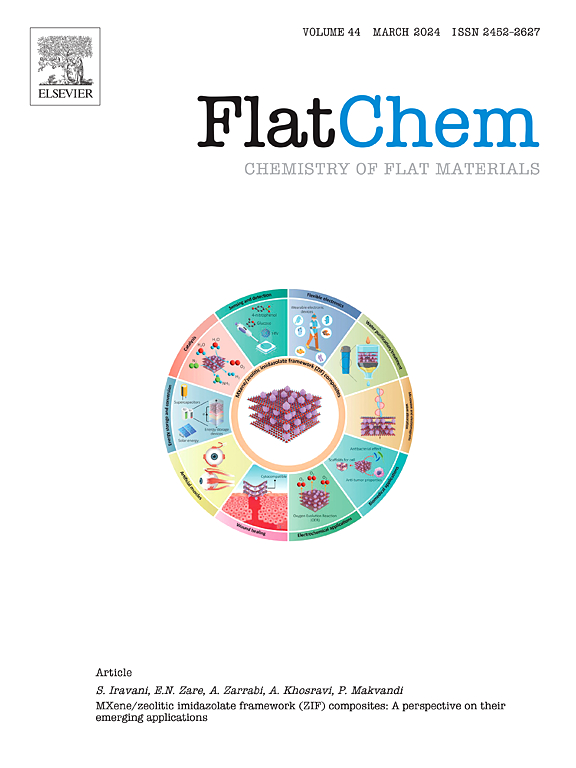巴西作物中Diuron的电化学测定:f-MWCNT@Chi-AgNPs纳米复合材料修饰的丝网印刷电极用于食品安全监测
IF 6.2
3区 材料科学
Q2 CHEMISTRY, PHYSICAL
引用次数: 0
摘要
在这项研究中,开发了一种廉价,易于制作的丝网印刷电化学(SPE)传感器,并将其应用于巴西作物中的diuron (DIU)检测。采用功能化碳纳米管、壳聚糖和纳米银组成的杂化纳米复合材料(f-MWCNT@Chi-AgNPs)对固相萃取进行了改性。以柠檬叶提取物为还原剂,通过简单快速的绿色合成得到了AgNPs。该传感器具有扩散控制响应的不可逆电化学行为。该传感器具有宽线性范围(0.02 ~ 50.0 μM)、低LOD (0.005 μM)和高灵敏度的特点。对pH、扫描速率等实验变量进行优化,确定pH 7.0为最优培养基。改进后的SPE传感器对常见干扰具有良好的选择性,工作稳定,无记忆效应。从M06-2X和B3LYP官能团以及Def2-SVP基集的DFT分析表明,DIU分子是一个中等亲电试剂。这些数据表明SPE/f-MWCNT@Chi-AgNPs对DIU的氧化具有高活性和稳定性。通过对橙果、橙汁、橘子、甘蔗、番茄等实际样品的分析,证实了该方法的实用性,回收率在100.09 ~ 110.61%之间,RSD < 4.0%。具有多孔结构的导电材料和可持续合成的结合产生了一个高效的分析平台。该传感器可作为一种可行、快速、有效的替代工具,用于复杂基质中农药残留的监测,在环境和食品质量分析中具有很强的应用潜力。本文章由计算机程序翻译,如有差异,请以英文原文为准。

Electrochemical determination of Diuron in Brazilian crops: f-MWCNT@Chi-AgNPs nanocomposite-modified screen-printed electrode for food safety monitoring
In this study, an inexpensive, easy-to-make screen-printed electrochemical (SPE) sensor was developed and applied for diuron (DIU) detection in Brazilian crops. The SPE was modified with a hybrid nanocomposite, which consisted of functionalized carbon nanotubes, chitosan and silver nanoparticles (f-MWCNT@Chi-AgNPs). The AgNPs were obtained through a simple and rapid green synthesis using lemon leaf extract as a reducing agent. The sensor exhibits irreversible electrochemical behavior with a diffusion-controlled response. The SPE-modified sensor when applied for DIU detection, was obtained a wide linear range (0.02–50.0 μM), a low LOD (0.005 μM), and a high sensitivity. Experimental variables, such as pH and scan rate were optimized, with pH 7.0 identified as the optimal medium. The modified SPE sensor demonstrated excellent selectivity against common interferents, operational stability, and no memory effect. The DFT analysis, from the M06-2X and B3LYP functionals, and the Def2-SVP basis set, reveals that the DIU molecule is a moderate electrophile. These data suggest the SPE/f-MWCNT@Chi-AgNPs are both highly reactive and stable for DIU oxidation. Its practical applicability was confirmed through the analysis of real samples (orange fruit, orange juice, tangerine, sugarcane and tomato), where recovery rates between 100.09 and 110.61 % were obtained, with RSD below 4.0 %. The combination of conductive materials with porous structure and sustainable synthesis yielded an efficient analytical platform. The proposed sensor can be employed as a viable, rapid and effective alternative tool for monitoring pesticide residues in complex matrices, with strong potential for application in environmental and food quality analysis.
求助全文
通过发布文献求助,成功后即可免费获取论文全文。
去求助
来源期刊

FlatChem
Multiple-
CiteScore
8.40
自引率
6.50%
发文量
104
审稿时长
26 days
期刊介绍:
FlatChem - Chemistry of Flat Materials, a new voice in the community, publishes original and significant, cutting-edge research related to the chemistry of graphene and related 2D & layered materials. The overall aim of the journal is to combine the chemistry and applications of these materials, where the submission of communications, full papers, and concepts should contain chemistry in a materials context, which can be both experimental and/or theoretical. In addition to original research articles, FlatChem also offers reviews, minireviews, highlights and perspectives on the future of this research area with the scientific leaders in fields related to Flat Materials. Topics of interest include, but are not limited to, the following: -Design, synthesis, applications and investigation of graphene, graphene related materials and other 2D & layered materials (for example Silicene, Germanene, Phosphorene, MXenes, Boron nitride, Transition metal dichalcogenides) -Characterization of these materials using all forms of spectroscopy and microscopy techniques -Chemical modification or functionalization and dispersion of these materials, as well as interactions with other materials -Exploring the surface chemistry of these materials for applications in: Sensors or detectors in electrochemical/Lab on a Chip devices, Composite materials, Membranes, Environment technology, Catalysis for energy storage and conversion (for example fuel cells, supercapacitors, batteries, hydrogen storage), Biomedical technology (drug delivery, biosensing, bioimaging)
 求助内容:
求助内容: 应助结果提醒方式:
应助结果提醒方式:


